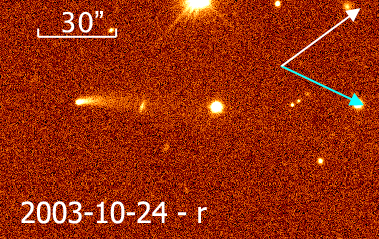Active Asteroids
This type of objects are used to be termed "Main-Belt Comets" formerly. Hitherto there are roughly twenty known active asteroids discovered. Only recently were they recognised as a new class of bodies in the solar system. They are dynamically asteroidal objects (Tisserand parameter with respect to Jupiter \(T_\mathrm{J} \ge 3\)), however, have been or are being observed to show evidence of cometary features. The interpretation of their activity includes varieties of physical mechanisms, such as sublimation of volatiles (e.g., 133P/Elst-Pizarro), thermal fracture (3200 Phaethon), rotational instability (e.g., P/2010 A2 (LINEAR)), impacts (596 Scheila), etc. The recognition of the active asteroids is of great significance because they probably form the third cometary reservoir, independent from the hypothetical Oort cloud and the Kuiper belt.Dynamicists have studied orbital evolution of the active asteroids, and the current conclusion is that it is difficult for a body with an origin from the Kuiper belt to maintain a main-belt like orbit. Inclusion of a nongravitational effect due to asymmetric mass-loss activity may push such an object into a main-belt orbit, however, the problem is that the nongravitational effect has to be excessively large (greater than that of comet 2P/Encke) and that the exerting time has to be rather long, much longer than the physical lifetime before exhaustion of volatiles. My advisor David Jewitt has a special page discussing the active asteroids wonderfully. For more technical information, please read Jewitt et al. (2015).
 |
| Active asteroid 313P/Gibbs observed by SDSS in UT 2003 Oct 24, Sloan-r' band. White and cyan arrows indicate the directions of the projected antisolar and the sky-plane projected heliocentric velocity vectors. The object was \(r_\mathrm{H} = 2.5\) AU away from the Sun. Taken from Hui & Jewitt (2015). |
Near-Sun Asteroids/Comets
I developed my interest in near-Sun
objects during my high school when participating in a citizen science
project where amateurs used coronagraphic images taken by the Solar and
Heliospheric Observatory (SOHO) and the Solar Terrestrial Relation
Observatory (STEREO). The sungrazing comets are the most famous family
in this class of objects, in that majority of the historically
brightest comets belonged to this family, such as the Great Comet in
1888. Unfortunately the definition about the sungrazing family remains
somewhat blurred, although it has long been identified since the late
nineteenth century by Kreutz (1888), after whom the Kreutz family was
named. So far the best scheme was by Walsh & Knight
(2012), which is that, an object that enters the Roche limit of the Sun
and suffers from gravitational tidal effects is a sungrazer. However,
it has its own imperfection, because the Roche limit is related to the
object's shape, nucleus spin state, and interior properties like bulk
density,
which are all poorly known. Generally speaking, sungrazing comets have
perihelion distances \(q < 5R_\odot\), where \(R_\odot = 0.00465\) AU is
the radius of the Sun.Other near-Sun types including the Meyer, Marsden and Kracht groups were all recognised in 2000s, whose perihelion distances have \(q > 6R_\odot\) approximately. The larger perihelion distances make them less susceptible to disintegration. The only evidence so far that such an object was being observed to disrupt is C/2015 D1 (SOHO) in 2015. According to a study led by me (Hui et al. 2015), the disintegration event was likely due to excessive pressure built up within its interior as the temperature gradient soared around its perihelion passage. Although there is no direct observational evidence about disruptions of members in the Meyer, Marsden and Kracht groups, yet dynamical analysis has revealed that they may be associated with comet 96P/Machholz and altogether may share the same progenitor in the past.
Nevertheless, because of proximity to the Sun around perihelia of the near-Sun bodies, disruption is prone to occurring. This potentially forms a great opportunity to investigate interiors of the small bodies as a natural laboratory, although their surfaces may be thermally evolved substantially. At the same time, however, because of near-Sun observing geometry, it is generally difficult to observe the near-Sun objects around their perihelia. So far the studies have to predominantly rely on data from SOHO and STEREO, both of which are not actually designed to conduct observations for small bodies and therefore the data quality is nasty if used for this kind of studies.
Dynamical evolution of the near-Sun bodies is of interest as well. There are a couple of dynamical processes which will finally result in a body moving in such an orbit. For instance, comet 2P/Encke may be evolving into a near-Sun orbit, driven by the \(\nu_6\) secular resonance. The Kozai mechanism can be responsible as well, as a result from conservation of the component of the orbital angular momentum perpendicular to the invariable plane of the Sun and main perturbers. A nongravitational acceleration whose transverse component in the orbital plane is anti-parallel to the veolcity component in the same direction will decrease the orbital angular momentum and energy of the body, therefore it will move sunwards gradually and finally becomes a near-Sun object.
Last Update: 2016/07/23